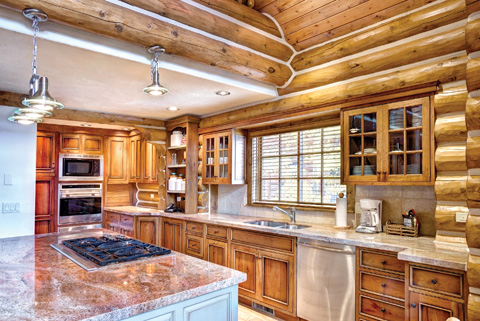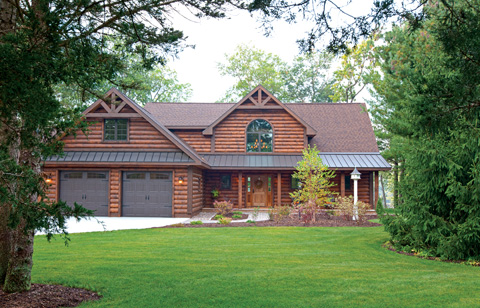A log home is not an impulse buy. For some the decision to build a log home was made years before they actually began the process of transforming a long-held dream into a lifetime reality.
“One of the first things is to establish how much you want to spend,” says Dave Fullerton, sales manager at Rocky Mountain Log Homes. “Is this a primary residence or vacation home? What genre of log home? Do you want the home to ‘feel’ a certain way? We try to establish this before we start the preliminary plan.” Fullerton says he works with homeowners to determine necessities as well as desires.
“Our goal is to help homeowners achieve a balance,” he says, referring to customer’s dreams, construction logistics, and long-term functionality. “If everyone really pays attention to details along the way and keeps an open communication, they can have the home they want … one that will become a legacy for the family.” Fullerton points out that among the practical matters that must be considered before a final plan can be drawn and a project budget established are accessibility during construction and after completion; requirements for and access to utilities such as water, sewage, electricity, gas, and Internet; and suitability of the terrain for building and landscaping.
Jeff Clements, vice president of Honest Abe Log Homes, adds that quality of life concerns like proximity to educational opportunities and medical facilities should be examined when selecting a location for a custom home, as well as options for entertainment, shopping, and recreation.
“Sometimes people fall in love with a piece of property that they can visualize their home on, and that property may meet all the logistical requirements,” Clements says, “but when they really think about how long it will take to get to a hospital or to be able to engage in their favorite activities, they may discover that the land is not so perfect after all.”
Clements suggests researching governmental or neighborhood regulations that could impede utilizing the property as planned. Reviewing area growth projections and the plans to address increases in population helps determine if the property will continue to be a desirable place as time goes by. “It’s best to weigh many factors before a purchase is made and a plan for a particular site is finalized,” Clements emphasizes.
Once a floorplan is completed, some homeowners feel more comfortable if they have obtained “apples-to-apples” quote comparisons on materials. “The key is to look at the details and ask a lot of questions,” says Coventry Log Homes’ vice president, Mark Elliott.
He says to ask if the subfloor system, porches, decks, and full pre-log gables are included. Confirm that the log wall system is precut, that the logs are graded and dry, and that the corners are interlocking. Ask what is included with the roof system, loft system, and staircase. Question whether the quote includes interior doors, framing, finish trims, and other materials for interior walls. Determine if the brand of windows and exterior doors is energy efficient. Ask about choices of color, finish trims, and glass.
“Be sure to question the ‘extras’,” he says. “For example, will engineered stamped plans be required, and if yes, does that cost extra? What about shipping cost? Are there hidden fees for customizing a plan?”

B Brown/shutterstock.com
Elliott advises shoppers to “make the log home company prove they have the most complete package with the best materials.”
Finalizing a plan and developing a detailed budget are mandatory if you are seeking project financing. It’s best to reduce debt as much as possible, and demonstrating an ability to save money creates a more favorable impression. Lenders advise preparing for a mortgage by taking steps to improve credit scores like paying off past-due bills, paying bills on time, and diligently maintaining a few solid credit accounts.
Armed with the perfect floorplan and log home producer, the right piece of property and money to pay for it, selection of a builder is vital to the entire project’s success.
Bryan Hogan, general manager of Old Virginia Log Homes, believes that any professional builder can finish a log home as easily as a conventional one once the logs are erected.
“That is, once you’re past the logs,” Hogan says, explaining that is why his company and many others build the log structure to dry-in stage. “Homeowners do not need a log home building specialist to finish out the home. They just need a builder with experience and integrity.”
Hogan encourages customers to use a general contractor within the area where the home will be built—one who knows and will choose competitive suppliers and qualified subcontractors. “It always goes smoother that way,” he says.
Some of the final tasks before moving into the home can be completed without hiring a professional.
“Painting, staining, sealing, installing fixtures and appliances, and handling final site cleanup all must be done,” says Gary Plante, owner of Cedar Hill Log Homes. “Not only does it save the homeowners money to do it themselves, they gain satisfaction from participating in the building process. These memories become part of the home’s history.”
The house’s sustainability can be achieved through proper maintenance, according to Greg Grimes, a partner at Expedition Log Homes, who says that maintenance planning begins during design—like incorporating stone, vinyl, or Hardie board.
“We can’t remove the need for some maintenance,” he says, “but you do not have to be a slave to upkeep.”
For example, Grimes says adding porches and wider overhangs protects the wood from harmful UV rays, while using a stone wrap keeps logs off the ground.
“Over the years we’ve seen a move toward half-logs and hybrids,” Grimes says, attributing that trend in part to reduced maintenance benefits. “Baby boomers want to enjoy their golden years, so they look for ways to make their homes more maintenance friendly.”
Log homes are durable, energy efficient, and beautiful. Creating and maintaining a wood home is not only rewarding, it is far easier than imagined.

